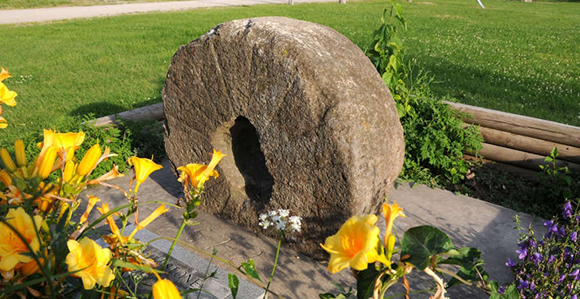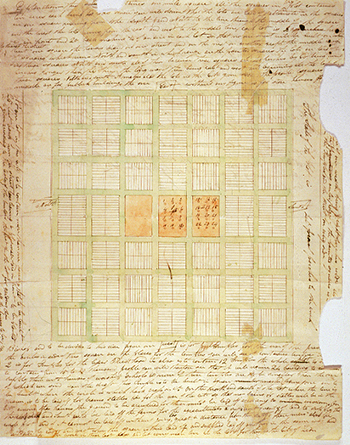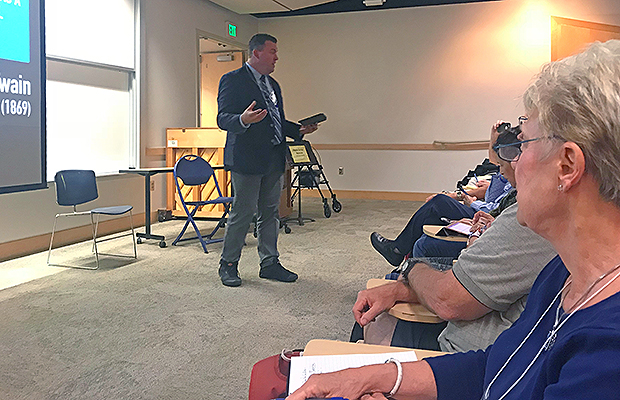Sacred Objects Help Connect Us to History, Says BYU Education Week Presenter
Contributed By Trent Toone, Deseret News staff writer

This millstone, on display in Breckenridge, Missouri, memorializes the Hawn’s Mill Massacre in 1838. The millstone is considered a sacred relic of the Restoration. Photo by Kenneth Mays.
Article Highlights
- History is not only just words that are written down or stories told from person to person. It’s also things.
“Touching and feeling history is sometimes a way for us to connect to the past in ways that are surprising and unique.” —Casey P. Griffiths, BYU associate professor of Church history
PROVO, UTAH
A few weeks ago, Casey P. Griffiths was touring Tarawa, an island atoll in the Pacific Ocean where a bloody World War II battle was fought between U.S. Marines and the Japanese forces.
While walking along the beach, Griffiths took photos of a tank still sunk into the sand. He also found what appeared to be a misfired 50-caliber shell in the surf. As he held the shell up for his audience to see, Griffiths said, “It was so amazing to walk up and actually see and touch and feel an object that participated in this battle.“
Griffiths, an associate professor of Church history at Brigham Young University, related the experience as part of his presentation, “Sacred Relics of the Restoration,” last Monday at BYU Education Week.
For the last year, Griffiths has worked with coauthor Mary Jane Woodger to take high-quality photographs of historic objects or relics from the history of The Church of Jesus Christ of Latter-day Saints in hopes of publishing a book with the working title A History of the Church in 100 Objects. The project is in the writing phase, Griffiths said.
“With that in mind, I want everybody in here to start thinking about history in the sense that it’s not just words that are written down or stories told from person to person. It’s things,” Griffiths said. “One of the unique things about our religion as Latter-day Saints is that we’re just a baby, speaking in terms of time. You can find things. Some of the most important discoveries in Church history have been found up in someone’s attic that no one knew about.”

A plat for the City of Zion in Missouri is featured in Joseph Smith Papers, Documents, Volume 3. The map is considered a sacred relic of the Restoration.

First edition of the Book of Mormon.

A young man examines Stephen Markham’s cane and John Taylor’s pocket watch, sacred relics of the Restoration, at the Church History Museum. Photo by Trent Toone, Deseret News.
Drawing upon material from the project, Griffiths discussed and showed a number of photos of historic Latter-day Saint objects, including the following items:
- The printer’s manuscript of the Book of Mormon
- The 1833 plat map for Zion in Jackson County, Missouri
- John Taylor’s damaged pocket watch
- The pepperbox pistol supposedly used by Joseph Smith in Carthage Jail
- A piece of stucco from the Kirtland Temple
- A Masonic apron owned by Joseph Smith
- The clothing Hyrum Smith was wearing when killed at Carthage Jail
- The millstone from Hawn’s Mill
- Joseph Fielding Smith’s typewriter
- The last all-Church basketball tournament trophy
- The pulpit from the chapel where President Thomas S. Monson served as a young bishop
- The radio used by Joseph Billy Johnson, a Latter-day Saint pioneer in Africa, to learn of the 1978 revelation on the priesthood
- A Mormon Helping Hands T-shirt
Material history is something everybody can relate to. Any object sanctified by our suffering, experiences, or sorrows can become a sacred object, Griffiths said.
“This is really an introduction to a type of history called material history, the most approachable type of history there is,” Griffiths said. “This is a part of history that’s touchable, that’s ‘feelable,’ that all of us have participated in. You may not have written a history book, but if you ever had your grandfather give you his mission journal, if you ever got a card from a relative, if you ever had a lock of hair from your ancestors, you’ve participated in material history. Touching and feeling history is sometimes a way for us to connect to the past in ways that are surprising and unique.”
Griffiths clarified that he’s not suggesting people become hoarders and keep everything, but certain objects will stand out over time.
“Pay attention to the objects of significance that get passed on to us and recognize that what you hold in your hand right now might seem like a worthless piece of junk, but in 200 years it might be a sacred relic that connects your ancestors to your time and connects people in the future with the struggles we have right now.”

Casey P. Griffiths, an associate professor of Church history at Brigham Young University, gives a presentation during BYU Education Week. Photo by Trent Toone, Deseret News.

In his BYU Education Week presentation, “Sacred Relics of the Restoration,” Casey Griffiths told about seeing this tank on the beach of Tarawa, an island in the Pacific Ocean. The tank was used in a bloody battle between U.S. Marines and the Japanese in World War II. Photo courtesy of Casey Griffiths.
